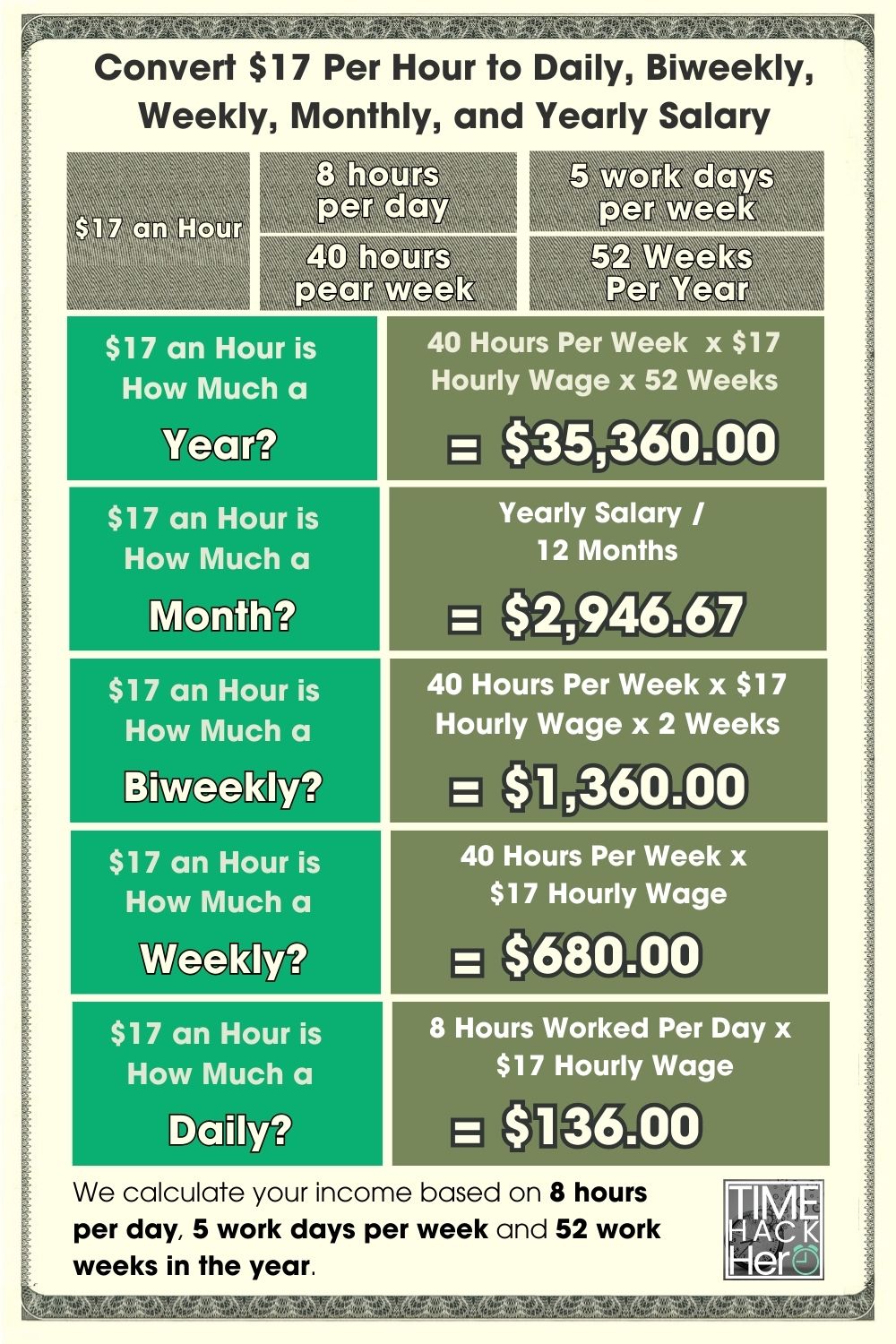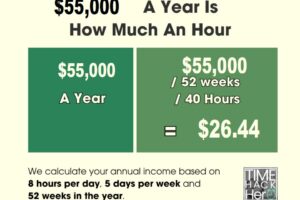Determining your annual earnings from an hourly wage is key for financial planning and understanding your income potential. In this article, we’ll break down the yearly salary for $17 per hour based on different work schedules.
We’ll calculate the pre-tax income for full-time and part-time jobs paying $17/hour. We’ll also look at how overtime pay can increase total yearly earnings. Since unpaid time off is a reality in most jobs, we’ll factor in how it reduces your actual annual income at this rate.
In addition, we’ll determine the after-tax salary you can expect to take home from $17 an hour after accounting for taxes and deductions. Understanding your net pay is crucial for budgeting.
We’ll also discuss whether $17 an hour is considered a good wage and what kind of lifestyle it can support. With inflation eating away at buying power, we’ll look at ways to boost earnings above $17/hour through education, skills development, and side gigs.
Knowing exactly how much you can expect to earn per year from $17 an hour is key for planning your finances. Let’s explore this important question in depth.
Table of Contents
Convert $17 Per Hour to Weekly, Monthly, and Yearly Salary
Input your wage and hours per week to see how much you’ll make monthly, yearly and more.
$17 an Hour is How Much a Year?
If you make $17 an hour, your yearly salary would be $35,360. We calculate your annual income based on 8 hours per day, 5 days per week and 52 weeks in the year.
Hours worked per week (40) x Hourly wage($17) x Weeks worked per year(52) = $35,360
$17 an Hour is How Much a Month?
If you make $17 an hour, your monthly salary would be $2,946.67. We calculated this number by dividing your annual income by 12 months.
Hours worked per week (40) x Hourly wage($17) x Weeks worked per year(52) / Months per Year(12) = $2,946.67
$17 an Hour is How Much a Biweekly?
If you make $17 an hour, your biweekly salary would be $1,360.
Hours worked per week (40) x Hourly wage($17) x 2 = $1,360
$17 an Hour is How Much a Week?
If you make $17 an hour, your weekly salary would be $680. Calculating based on 5 days per week and 8 hours each day.
Hours worked per week (40) x Hourly wage($17) = $680
$17 an Hour is How Much a Day?
If you make $17 an hour, your daily salary would be $136. We calculated your daily income based on 8 hours per day.
Hours worked per day (8) x Hourly wage($17) = $136
$17 an Hour is How Much a Year?
The basic formula to calculate your annual salary from an hourly wage is:
Hourly Rate x Hours Worked per Week x Number of Weeks Worked per Year = Annual Salary
So for a $20 per hour job:
$17 per hour x 40 hours per week x 52 weeks per year = $35,360
However, this simple calculation makes some assumptions:
- You will work 40 hours every week of the year
- You will not get any paid time off
Therefore, it represents your earnings if you worked every week of the year, without any vacation, holidays, or sick days.
Accounting for Paid Time Off
The $35,360 base salary does not yet factor in paid time off (PTO). Let’s assume the job provides:
- 2 weeks (10 days) paid vacation
- 6 paid holidays
- 3 paid sick days
This totals 19 paid days off, or nearly 4 weeks of PTO.
Importantly, this paid time off should not be deducted from the annual salary, since you still get paid for those days.
So with 4 weeks PTO, the annual salary would remain $35,360 .
Part time $17 an hour is How Much a Year?
Your annual income changes significantly if you work part-time and not full-time.
For example, let’s say you work 25 hours per week instead of 40. Here’s how you calculate your new yearly total:
$17 per hour x 25 hours per week x 52 weeks per year = $22,100
By working 15 fewer hours per week (25 instead of 40), your annual earnings at $17 an hour drop from $35,360 to $22,100.
That’s a $13,260 per year difference just by working part-time!
Here’s a table summarizing how your annual earnings change depending on how many hours you work per week at $17 an hour:
| Hours Per Week | Earnings Per Week | Annual Earnings |
|---|---|---|
| 40 | $680 | $35,360 |
| 35 | $595 | $30,940 |
| 30 | $510 | $26,520 |
| 25 | $425 | $22,100 |
| 20 | $340 | $17,680 |
| 15 | $255 | $13,260 |
The more hours per week, the higher your total yearly earnings. But part-time work allows for more life balance if you don’t need the full salary.
$17 an Hour With Overtime is How Much a Year?
Now let’s look at how overtime can increase your annual earnings.
Overtime kicks in once you work more than 40 hours in a week. Typically, you earn 1.5x your regular hourly wage for overtime hours.
So if you make $17 per hour normally, you would make $25.50 per hour for any hours over 40 in a week.
Here’s an example:
- You work 45 hours in a Week
- 40 regular hours paid at $17 per hour = $680
- 5 overtime hours paid at $25.50 per hour = $127.50
- Your total one Week earnings =$680 + $127.50 = $807.50
If you worked 45 hours each week for 52 weeks, here’s how your annual earnings increase thanks to overtime pay:
$807.50 per week x 52 weeks per year = $41,990
That’s $6,630 more than you’d earn working just 40 hours per week at $17 an hour.
Overtime can add up! But also consider taxes and work-life balance when deciding on extra hours.
Here’s a table summarizing how your annual earnings change depending on how many hours you work per week at $17 an hour:
| Overtime hours per work day | Hours Per Week | Earnings Per Week | Annual Earnings |
| 0 | 40 | $680 | $35,360 |
| 1 | 45 | $807.50 | $41,990 |
| 2 | 50 | $935 | $48,620 |
| 3 | 55 | $1,062.50 | $55,250 |
| 4 | 60 | $1,190 | $61,880 |
| 5 | 65 | $1,317.50 | $68,510 |
| 6 | 70 | $1,445 | $75,140 |
| 7 | 75 | $1,572.50 | $81,770 |
How Unpaid Time Off Impacts $17/Hour Yearly Earnings
So far we’ve assumed you work 52 paid weeks per year. Any unpaid time off will reduce your total income.
For example, let’s say you take 2 weeks of unpaid leave. That brings your paid weeks down to 50:
Hours worked per week (40) x Hourly wage($17) x Weeks worked per year(50) = $34,000 annual salary
With 2 weeks unpaid time off, your annual earnings at $17/hour would drop by $1,360.
The table below summarizes how your annual income changes depending on the number of weeks of unpaid leave.
| Weeks of unpaid leave | Paid weeks per year | Earnings Per Week | Annual Earnings |
| 0 | 52 | $680 | $35,360 |
| 1 | 51 | $680 | $34,680 |
| 2 | 50 | $680 | $34,000 |
| 3 | 49 | $680 | $33,320 |
| 4 | 48 | $680 | $32,640 |
| 5 | 47 | $680 | $31,960 |
| 6 | 46 | $680 | $31,280 |
| 7 | 45 | $680 | $30,600 |
Key Takeaways for $17 Hourly Wage
In summary, here are some key points on annual earnings when making $17 per hour:
- At 40 hours per week, you’ll earn $35,360 per year.
- Part-time of 30 hours/week results in $26,520 annual salary.
- Overtime pay can boost yearly earnings, e.g. $6,630 extra at 45 hours/week.
- Unpaid time off reduces your total income, around $1,360 less per 2 weeks off.
- Your specific situation and location impacts taxes and PTO.
Knowing your approximate annual salary and factors impacting it makes it easier to budget and plan your finances. The next step is calculating take-home pay after deductions like taxes.
$17 An Hour Is How Much A Year After Taxes
Figuring out your actual annual earnings based on an hourly wage can be complicated once taxes are taken into account. In addition to federal, state, and local income taxes, 7.65% of your gross pay also goes to Social Security and Medicare through FICA payroll taxes. So how much does $17 an hour equal per year after FICA and income taxes are deducted from your gross pay?
Below we’ll walk through the steps to calculate your annual net take home pay if you make $17 per hour. This will factor in estimated federal, FICA, state, and local taxes so you know exactly what to expect.
Factoring in Federal Income Tax
Your federal income tax will be a big chunk out of your gross pay. Federal tax rates range from 10% to 37%, depending on your tax bracket.
To estimate your federal income tax rate and liability:
Look up your federal income tax bracket based on your gross pay.
2023 tax brackets: single filers
| Tax rate | Taxable income bracket | Tax owed |
|---|---|---|
| 10% | $0 to $11,000. | 10% of taxable income. |
| 12% | $11,001 to $44,725. | $1,100 plus 12% of the amount over $11,000. |
| 22% | $44,726 to $95,375. | $5,147 plus 22% of the amount over $44,725. |
| 24% | $95,376 to $182,100. | $16,290 plus 24% of the amount over $95,375. |
| 32% | $182,101 to $231,250. | $37,104 plus 32% of the amount over $182,100. |
| 35% | $231,251 to $578,125. | $52,832 plus 35% of the amount over $231,250. |
| 37% | $578,126 or more. | $174,238.25 plus 37% of the amount over $578,125. |
For example, if you are single with $35,360 gross annual pay, your federal tax bracket is 12%.
Your estimated federal tax would be:
$1,100 + ($35,360 – $11,000) x 12% = $4,023.20
So at $17/hour with $35,360 gross pay, you would owe about $4,023.20 in federal income taxes.
Considering State Income Tax
In addition to federal tax, most states also charge a state income tax. State income tax rates range from about 1% to 13%, with most falling between 4% and 6%.
Key Takeaways
-
- California, Hawaii, New York, New Jersey, and Oregon have some of the highest state income tax rates.
- Alaska, Florida, Nevada, South Dakota, Tennessee, Texas, Washington, and Wyoming don’t impose an income tax at all.
- Another 10 U.S states have a flat tax rate—everyone pays the same percentage regardless of how much they earn.
A State-by-State Comparison of Income Tax Rates
| STATE | TAX RATES | LOWEST AND HIGHEST INCOME BRACKETS |
|---|---|---|
| Alaska | 0% | None |
| Florida | 0% | None |
| Nevada | 0% | None |
| South Dakota | 0% | None |
| Tennessee | 0% | None |
| Texas | 0% | None |
| Washington | 0% | None |
| Wyoming | 0% | None |
| Colorado | 4.55% | Flat rate applies to all incomes |
| Illinois | 4.95% | Flat rate applies to all incomes |
| Indiana | 3.23% | Flat rate applies to all incomes |
| Kentucky | 5% | Flat rate applies to all incomes |
| Massachusetts | 5% | Flat rate applies to all incomes |
| New Hampshire | 5% | Flat rate on interest and dividend income only |
| North Carolina | 4.99% | Flat rate applies to all incomes |
| Pennsylvania | 3.07% | Flat rate applies to all incomes |
| Utah | 4.95% | Flat rate applies to all incomes |
| Michigan | 4.25% | Flat rate applies to all incomes |
| Arizona | 2.59% to 4.5% | $27,806 and $166,843 |
| Arkansas | 2% to 5.5% | $4,300 and $8,501 |
| California | 1% to 13.3% | $9,325 and $1 million |
| Connecticut | 3% to 6.99% | $10,000 and $500,000 |
| Delaware | 0% to 6.6% | $2,000 and $60,001 |
| Alabama | 2% to 5% | $500 and $3,001 |
| Georgia | 1% to 5.75% | $750 and $7,001 |
| Hawaii | 1.4% to 11% | $2,400 and $200,000 |
| Idaho | 1.125% to 6.5% | $1,568 and $7,939 |
| Iowa | 0.33% to 8.53% | $1,743 and $78,435 |
| Kansas | 3.1% to 5.7% | $15,000 and $30,000 |
| Louisiana | 1.85% to 4.25% | $12,500 and $50,001 |
| Maine | 5.8% to 7.15% | $23,000 and $54,450 |
| Maryland | 2% to 5.75% | $1,000 and $250,000 |
| Minnesota | 5.35% to 9.85% | $28,080 and $171,221 |
| Mississippi | 0% to 5% | $5,000 and $10,001 |
| Missouri | 1.5% to 5.3% | $1,121 and $8,968 |
| Montana | 1% to 6.75% | $2,900and $17,400 |
| Nebraska | 2.46% to 6.84% | $3,340 and $32,210 |
| New Jersey | 1.4% to 10.75% | $20,000 and $1 million |
| New Mexico | 1.7% to 5.9% | $5,500 and $210,000 |
| New York | 4% to 10.9% | $8,500 and $25 million |
| North Dakota | 1.1% to 2.9% | $41,775 and $458,350 |
| Ohio | 0% to 3.99% | $25,000 and $110,650 |
| Oklahoma | 0.25% to 4.75% | $1,000 and $7,200 |
| Oregon | 4.75% to 9.9% | $3,750 and $125,000 |
| Rhode Island | 3.75% to 5.99% | $68,200 and $155,050 |
| South Carolina | 0% to 7% | $3,110 and $15,560 |
| Vermont | 3.35% to 8.75% | $42,150 and $213,150 |
| Virginia | 2% to 5.75% | $3,000 and $17,001 |
| Washington, D.C. | 4% to 9.75% | $10,000 and $1 million |
| West Virginia | 3% to 6.5% | $10,000 and $60,000 |
| Wisconsin | 3.54% to 7.65% | $12,760 and $280,950 |
To estimate your state income tax:
Look up your state income tax rate based on your gross pay and filing status.
Multiply your gross annual pay by the state tax rate.
For example, if you live in Pennsylvania which has a flat 3.07% tax rate, your estimated state tax would be:
$35,360 gross pay x 3.07% PA tax rate = $1,085.55 estimated state income tax
So with $35,360 gross annual income, you would owe around in $1,085.55 Pennsylvania state income tax. Verify your specific state’s income tax rates.
Factoring in Local Taxes
Some cities and counties levy local income taxes ranging from 1-3% of taxable income.
To estimate potential local taxes you may owe:
- Check if your city or county charges a local income tax.
- If yes, look up the local income tax rate.
- Multiply your gross annual pay by the local tax rate.
For example, say you live in Columbus, OH which has a 2.5% local income tax. Your estimated local tax would be:
$35,360 gross pay x 2.5% local tax rate = $884 estimated local tax
So with $35,360 in gross earnings, you may owe around $884 in Columbus local income taxes. Verify rates for your own city/county.
Accounting for FICA Taxes (Social Security & Medicare)
FICA taxes are a combination of Social Security and Medicare taxes that equal 15.3% of your earnings. You are responsible for half of the total bill (7.65%), which includes a 6.2% Social Security tax and 1.45% Medicare tax on your earnings.
In 2023, only the first $160,200 of your earnings are subject to the Social Security tax
There is an additional 0.9% surtax on top of the standard 1.45% Medicare tax for those who earn over $200,000 (single filers) or $250,000 (joint filers).
To estimate your FICA tax payment:
$35,360 x 6.2% + $35,360 x 1.45% = $2,705.04
So you can expect to pay about $2,705.04 in Social Security and Medicare taxes out of your gross $35,360 in earnings.
Total Estimated Tax Payments
Based on the examples above, your total estimated tax payments would be:
Federal tax: $4,023.20
State tax: $1,085.55
Local tax: $884
FICA tax: $2,705.04
Total Estimated Tax: $8,697.79
Calculating Your Take Home Pay
To calculate your annual take home pay at $17 /hour:
1. Take your gross pay
2. Subtract your estimated total tax payments
$35,360 gross pay – $8,697.79 Total Estimated Tax = $26,662.21 Your Take Home Pay
n summary, if you make $17 per hour and work full-time, you would take home around $26,662.21 per year after federal, state, local , FICA taxes.
Your actual net income may vary depending on your specific tax situation. But this gives you a general idea of what to expect.
Convert $17 Per Hour to Yearly, Monthly, Biweekly, and Weekly Salary After Taxes
If you make $17 an hour and work full-time (40 hours per week), your estimated yearly salary would be $35,360 .
The $35,360 per year salary does not account for taxes. Federal, state, and local taxes will reduce your take-home pay. The amount withheld depends on your location, filing status, dependents, and other factors.
Just now during our calculation of $17 An Hour Is How Much A Year After Taxes, we assumed the following conditions:
- You are single with $35,360 gross annual pay, your federal tax bracket is 12 %.
- You live in Pennsylvania which has a flat 3.07% tax rate
- You live in Columbus, OH which has a 2.5% local income tax.
In the end, we calculated your Total Estimated Tax is $8,697.79 , Your Take Home Pay is $26,662.21 , Total tax rate is 24.60%.
So next we’ll use 24.60% as the estimated tax rate to calculate your weekly, biweekly, and monthly after-tax income.
$17 Per Hour to Yearly, Monthly, Biweekly, Weekly,and Week Salary After Taxes Table
| Income before taxes | Estimated Tax Rate | Income Taxes | After Tax Income | |
| Yearly Salary | $35,360 | 24.60% | $8,697.79 | $26,662.21 |
| Monthly Salary | $2,946.67 | 24.60% | $724.82 | $2,221.85 |
| BiWeekly Salary | $1,360 | 24.60% | $334.53 | $1,025.47 |
| Weekly Salary | $680 | 24.60% | $167.27 | $512.73 |
$17 an hour is how much a year after taxes
Here is the adjusted yearly salary after a 24.60% tax reduction:
-
- Yearly salary before taxes: $35,360
- Estimated tax rate: 24.60%
- Taxes owed (24.60% * $35,360 )= $8,697.79
- Yearly salary after taxes: $26,662.21
| Hourly Wage | Hours Worked Per Week | Weeks Worked Per Year | Total Yearly Salary | Estimated Tax Rate | Taxes Owed | After-Tax Yearly Salary |
|---|---|---|---|---|---|---|
| $17 | 40 | 52 | $35,360 | 24.60% | $8,697.79 | $26,662.21 |
$17 an hour is how much a month after taxes
To calculate the monthly salary based on an hourly wage, you first need the yearly salary amount. Then divide by 12 months.
-
-
- Yearly salary before taxes at $17 per hour: $35,360
- Divided by 12 months per year: $35,360 / 12 = $2,946.67 per month
-
The monthly salary based on a 40 hour work week at $17 per hour is $2,946.67 before taxes.
After applying the estimated 24.60% tax rate, the monthly after-tax salary would be:
-
- Monthly before-tax salary: $2,946.67
- Estimated tax rate: 24.60%
- Taxes owed (24.60% * $2,946.67 )= $724.82
- Monthly after-tax salary: $2,221.85
Monthly Salary Based on $17 Per Hour
| Hourly Wage | Yearly Salary | Months Per Year | Before-Tax Monthly Salary | Estimated Tax Rate | Taxes Owed | After-Tax Monthly Salary |
|---|---|---|---|---|---|---|
| $17 | $35,360 | 12 | $2,946.67 | 24.60% | $724.82 | $2,221.85 |
$17 an hour is how much biweekly after taxes
Many people are paid biweekly, meaning every other week. To calculate the biweekly pay at $17 per hour:
- Hourly wage: $17
- Hours worked per week: 40
- Weeks per biweekly pay period: 2
- $17 * 40 hours * 2 weeks = $1,360 biweekly
Applying the 24.60%estimated tax rate:
- Biweekly before-tax salary: $1,360
- Estimated tax rate: 24.60%
- Taxes owed (24.60% * $1,360 )= $334.53
- Biweekly after-tax salary: $1,025.47
Biweekly Salary at $17 Per Hour
| Hourly Wage | Hours Worked Per Week | Weeks Per Pay Period | Before-Tax Biweekly Salary | Estimated Tax Rate | Taxes Owed | After-Tax Biweekly Salary |
|---|---|---|---|---|---|---|
| $17 | 40 | 2 | $1,360 | 24.60% | $334.53 | $1,025.47 |
$17 an hour is how much weekly after taxes
To find the weekly salary based on an hourly wage, you need to know the number of hours worked per week. At 40 hours per week, the calculation is:
- Hourly wage: $17
- Hours worked per week: 40
- $17 * 40 hours = $680 per week
Accounting for the estimated 24.60% tax rate:
- Weekly before-tax salary: $680
- Estimated tax rate: 24.60%
- Taxes owed (24.60% * $680 )= $167.27
- Weekly after-tax salary: $512.73
Weekly Salary at $17 Per Hour
| Hourly Wage | Hours Worked Per Week | Before-Tax Weekly Salary | Estimated Tax Rate | Taxes Owed | After-Tax Weekly Salary |
|---|---|---|---|---|---|
| $17 | 40 | $680 | 24.60% | $167.27 | $512.73 |
Key Takeaways
- An hourly wage of $17 per hour equals a yearly salary of $35,360 before taxes, assuming a 40 hour work week.
- After accounting for an estimated 24.60% tax rate, the yearly after-tax salary is approximately $26,662.21 .
- On a monthly basis before taxes, $17 per hour equals $2,946.67 per month. After estimated taxes, the monthly take-home pay is about $2,221.85 .
- The before-tax weekly salary at $17 per hour is $680 . After taxes, the weekly take-home pay is approximately $512.73 .
- For biweekly pay, the pre-tax salary at $17 per hour is $1,360 . After estimated taxes, the biweekly take-home pay is around $1,025.47 .
Understanding annual, monthly, weekly, and biweekly salary equivalents based on an hourly wage is useful when budgeting and financial planning. Taxes make a significant difference in take-home pay, so be sure to account for them when making income conversions. Use this guide as a reference when making salary calculations.
What Is the Average Hourly Wage in the US?
Last Updated: Sep 1 2023
US Average Hourly Earnings is at a current level of $33.82, up from 33.74 last month and up from 32.43 one year ago. This is a change of 0.24% from last month and 4.29% from one year ago.
Average Hourly Earnings is the average dollars that a private employee makes per hour in the US. This metric is a part of one of the most important releases every month which includes unemployment numbers as well. This is normally released on the first Friday of every month. This metric is released by the Bureau of Labor Statistics (BLS).
What is the average salary in the U.S.?
Last Updated: July 18, 2023
The U.S. Bureau of Labor Statistics uses median salary data rather than averages to avoid skewed numbers from outlying high and low numbers. Median weekly earnings of the nation's 121.5 million full-time wage and salary workers were $1,100 in the second quarter of 2023, the U.S.
If a person works 52 weeks in the year, then this represents a national annual salary of $57,200.
Is $17 an Hour a Good Salary?
Whether or not $17 per hour is considered a good wage depends heavily on where you live, your lifestyle, and household size.
For a single person living in a small town or rural area, $17 an hour can certainly provide a decent quality of life. However, for expensive coastal cities like Los Angeles, New York City, Seattle, Miami, and others, trying to live on $17 an hour would prove extremely difficult.
Let’s examine some data from the MIT Living Wage Calculator on required income for a single adult to meet a minimum living standard:
- New York City: $20.19 per hour
- Chicago: $15.24 per hour
- Houston: $15.35 per hour
- Charlotte: $13.92 per hour
- Sioux Falls, SD: $12.07 per hour
In lower cost regions, $17 an hour meets or exceeds typical living wages. But it falls far short in pricier metropolitan areas.
The situation becomes even more challenging when trying to support a family on $17 per hour. As household size increases, so do expenses. While a single person may scrape by, it would require major cutbacks and government assistance to provide for 2+ children at this wage.
Jobs that pay $17 an hour
There are a variety of occupations that typically pay close to $17 per hour:
- Medical assistants – Work alongside doctors and nurses providing clinical and administrative support in hospitals, clinics, and medical offices. May require an associate’s degree or postsecondary certificate.
- Preschool teachers – Instruct children below kindergarten age at daycares, preschools, and pre-K programs. Typically need an associate’s degree in early childhood education.
- Security guards – Protect property, assets, and people by monitoring premises and checking credentials. Most employers require a high school diploma or GED.
- Food service supervisors – Manage operations and staff at restaurants, cafeterias, and other dining establishments. Usually need 1-3 years of experience in food service.
- Retail associates – Assist customers, process transactions, stock shelves, and perform other duties in retail stores. Many employers provide on-the-job training.
- Receptionists – Greet visitors, answer phone calls, route correspondence, and provide administrative support in an office setting. May require some college coursework or vocational classes.
- Bank tellers – Process deposits/withdrawals and provide customer service in a bank branch. Most positions require a high school diploma and strong math abilities.
- Tax preparers – Prepare tax returns and forms for individuals and small businesses. Typically need an associate’s degree in accounting or related field.
These are some examples of jobs paying in the $15 to $19 per hour range. Education and experience requirements vary.
Can You Live Off $17 An Hour?
Whether it’s possible to live comfortably on $17 an hour depends largely on where you live and your overall budget. For single adults without children in low cost-of-living areas of the country, it is certainly achievable to live on this wage. However, for those supporting families or living in major metros, it would require substantial cutbacks and strict budgeting.
To determine if you can live on $17/hour, start by outlining your monthly expenses:
- Housing costs
- Transportation
- Food
- Utilities
- Healthcare
- Debt obligations
- Leisure & entertainment
- Miscellaneous expenses
Experts recommend spending a maximum of 30% of your pretax income on housing. For someone earning $17 an hour or ~$2,933 per month before taxes, that’s $880 allocated to rent/mortgage, insurance, utilities, etc.
In many smaller Midwest, South, and Southwest towns, finding housing at or below that threshold is realistic. But major coastal cities will prove far more challenging without roommates or subsidies.
Overall, maintaining a strict budget, minimizing any unnecessary costs, and avoiding high housing expenses is key to living comfortably on $17 per hour. Sharing housing and limiting debt obligations also helps significantly.
The impact of inflation on the value of $17 an hour
With inflation recently hitting its highest level in 40 years, the real value of $17 an hour has decreased notably. While nominal wage growth has somewhat kept pace over the past couple years, accounting for inflation shows most workers have experienced a decline in real wages.
In 2021, $17 an hour resulted in annual earnings of around $35,360. But with inflation around 8-9% annually, real wages have dropped by several percentage points.
This means that even though $17 per hour provides the same gross pay as last year, employees are able to purchase fewer goods and services with their income due to rising prices. From housing and food costs to transportation, healthcare, and education, most major household expenses have become more expensive.
Unless wages start rising faster than inflation (for example, getting a 10% raise when inflation is 8%), workers will continue losing purchasing power. This decline in real wages from inflation hits lower and middle income households the hardest.
For those earning $17 an hour or similar wages, it’s becoming even more difficult to maintain their quality of life and afford basic necessities. This is an important challenge for individuals, families, and policymakers alike.
5 Ways To Increase Your Hourly Wage
If you currently earn around $17 per hour but are struggling to make ends meet, here are some options to boost your income:
- Ask for a raise – If you’ve been at your company for a while and have a strong performance history, request a pay increase to keep pace with rising costs.
- Find a higher paying job – Browse job boards and company sites to find openings that offer better compensation. Update your resume and LinkedIn profile.
- Develop new skills – Take classes, online courses, or training programs to gain skills that qualify you for better-paying roles.
- Start a side business – Offer services like bookkeeping, tutoring, rideshare driving, or selling products online to earn supplemental income.
- Negotiate benefits – If your employer won’t raise wages, see if they can improve benefits like more paid vacation days and flexible schedules.
- Move to a lower cost area – Research cities or towns with a lower cost of living where your earnings will stretch further.
- Pick up side work – Take on part-time gigs like dog walking, bartending, landscaping, etc. to boost your overall income.
Pursuing a combination of these strategies can provide the extra income many need to live comfortably on $17 an hour.
Buying a car on $17 an hour
For most households, access to a reliable vehicle is necessary to commute to work, transport family, and complete errands. But cars come with a significant cost. Is buying a car realistic if you earn $17 an hour?
The short answer – yes, with careful planning and budgeting. The average monthly car payment currently sits around $550. For someone making $17 per hour or ~$2,933 in monthly pre-tax income, a $550 payment accounts for nearly 19% of gross income – above the 15% maximum recommendation.
Here are some tips for purchasing a car on a $17 per hour salary:
- Shop used vehicles – Gently used cars are 40-60% cheaper than new. Search for well-maintained used models with lower miles.
- Secure pre-approval – Talk to banks or credit unions to get pre-approved for an auto loan first. This lets you know your budget before shopping.
- Prioritize reliability – Look for vehicles with proven reputations for durability and lower repair costs. Avoid models prone to issues.
- Extend your loan term – Opting for a 60-month or 72-month repayment term instead of 48 months lowers the monthly payment. Just avoid terms that are too long.
- Buy well below your limit – Only spend significantly less than the maximum payment you’re approved for. This leaves budget room for other ownership costs.
- Make a sizeable down payment – Putting 10-20% down reduces the financed amount and monthly payment. Pay in cash if you can.
As long as you shop smart, get pre-approved, and choose affordable payments, buying a vehicle on a $17 per hour salary is certainly achievable. Just be diligent about budgeting for added expenses like insurance, gas, and repairs.
Can You Buy a House on $17 An Hour?
For most people, buying a house remains a major financial goal and wealth builder. But is homeownership realistic if you earn around $17 per hour?
In most housing markets, purchasing a home solely on this salary would be extremely difficult. However, it may be possible with discipline, preparation, and certain strategies:
- Save a sizable down payment – Shooting for 20% down or more is key to keep monthly mortgage costs manageable. It will take disciplined saving over several years to amass this on $17/hour.
- Utilize first-time homebuyer programs – These provide grants, loans, and assistance specifically for those buying their first home who meet income and location requirements.
- Look into USDA, VA loans – These specialized mortgages offer little to no down payment options, lower rates, and flexible credit requirements for those who qualify.
- Focus on cheaper markets – You’ll have much more buying power in cities and towns with lower home prices, property taxes, and cost of living. Avoid pricier urban areas.
- Purchase a modest starter home – Opt for a small, older home with fewer amenities. This reduces purchase price as well as maintenance and repair costs.
- Bring in supplemental income – Additional income from a part-time job or side business can help you better afford mortgage payments and other housing expenses.
- Get a co-signer – Having a co-signer with strong credit helps you qualify for a mortgage and get better loan terms.
While very challenging, homeownership on $17 an hour is possible with diligent preparation, compromise on amenities, and supplemental income. Just be realistic about how much house you can safely afford.
Example Budget For $17 Per Hour
To determine if living on $17 an hour is realistic for your situation, map out an example monthly budget:
Income
- Monthly Take-Home Pay (after taxes): $2,680
- Side Income: $400
- Total: $3,080
Expenses
- Rent (with roommates): $700
- Used Car Payment: $180
- Car Insurance: $100
- Gas: $80
- Groceries: $240
- Dining Out: $150
- Entertainment: $75
- Utilities: $130
- Phone: $80
- Internet: $50
- Medical: $50 (with employer insurance)
- Miscellaneous: $100
- Total: $1,935
Remaining:
- $1,145 left per month
This allows you to cover all typical living expenses in many areas, plus build savings and have extra wiggle room. An $17 per hour wage can certainly support a moderate lifestyle with careful budgeting.
However, this varies substantially depending on your unique situation:
- Housing availability and costs
- Debt obligations
- Family size
- Healthcare needs
Single adults and dual-income couples stand the best chance of living comfortably on this salary. But families with multiple dependents or single parents would struggle without major cutbacks or government assistance.
In Summary
For single people and working couples without children, $17 an hour can provide a livable wage in many areas, especially lower cost regions. However, it requires disciplined budgeting, finding ways to maximize income, minimizing expenses, and likely making some lifestyle compromises. For those with families or in high-priced metros, $17 an hour presents substantial challenges without sufficient aid.
The value of $17 an hour has also declined notably over the past couple years due to rampant inflation. So while nominal wages may rise slightly, workers still suffer a squeeze in real purchasing power. This makes thriving on $17 an hour much more difficult compared to prior to the pandemic.
Overall, living on $17 per hour is certainly possible depending on your individual circumstances. But it leaves little room for financial surprises and requires diligent money management. Supplementing with side income is key for many to live comfortably at this wage level. With proper preparation and reasonable expectations, a $17 per hour salary can support a simple but decent lifestyle.










